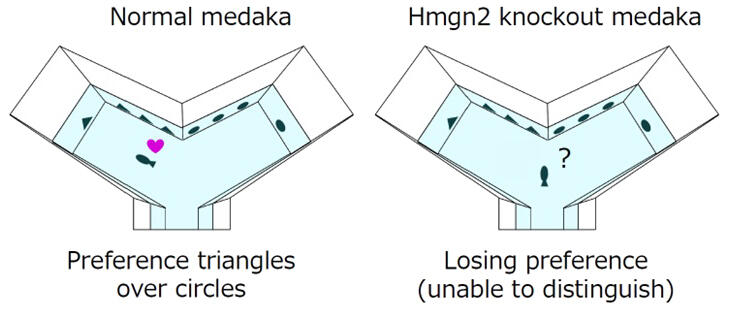A research group led by Assistant Professor Saori Yokoi of the Faculty of Pharmaceutical Sciences at Hokkaido University announced that the Hmgn2 gene in medaka fish has a sequence significantly different from that of other species and is involved in shape recognition ability. Medaka with a knockout Hmgn2 gene lost their preference (for a zone with triangular rather than circular visual cues) and exhibited abnormal shape recognition. The findings are expected to help in understanding the origins of higher-level cognitive abilities related to vision. The results were published in the international journal Communications Biology on August 23.

Provided by Saori Yokoi, Hokkaido University
The Hmgn2 gene is predominantly expressed in neural progenitor cells and is highly conserved from fish to mammals in both sequence and function. In mice, deletion of this gene has been reported to result in microcephaly and a high mortality rate.
In this study, the research group focused on the medaka Hmgn2 gene in the process of searching for functionally unknown genes expressed in the medaka brain. Comparison of the medaka Hmgn2 gene with the Hmgn family of other species revealed that medaka Hmgn2 had low similarity to Hmgn2 in other species, whereas Hmgn1 and Hmgn3 showed high similarities across species. The research group also showed that only fish in the group Acanthopterygii, to which the medaka belongs, have unique Hmgn2 that other groups do not have."
Using genome editing technology, they created medaka fish incapable of synthesizing functional Hmgn2 (Hmgn2-knockout medaka). Hmgn2-knockout medaka had no major abnormalities in appearance, unlike Hmgn2-knockout mice. Meanwhile, detailed analysis revealed that certain regions of the telencephalon, which correspond to the cerebrum of mammals, were smaller in Hmgn2-knockout medaka. These regions have been reported to be involved in shape recognition in zebrafish.
In response, the group used a behavioral experiment to test shape recognition ability. A Y-maze tank with one zone lined with circles in one arm and another zone lined with triangles in the other arm was constructed, and they tested whether medaka prefer the circle or triangle zone. The results revealed that normal medaka preferred triangles over circles. Furthermore, Hmgn2-knockout medaka lost this preference.
The observed behavioral abnormality is attributable to defective shape perception due to the reduction in the size of certain brain regions. Medaka have higher-level cognitive abilities using vision, such as distinguishing other individuals based on their faces. This study suggests that Hmgn2 is involved in the acquisition of such higher-level cognitive abilities. Also, this study is the first to identify that Hmgn2 is a gene that affects shape recognition in fish. Moving forward, they intend to advance the study toward the clarification of the mechanisms necessary for higher-level cognitive abilities using vision.
Yokoi said, "A student who was working on a completely different topic had previously consulted me and said, 'Medaka may like triangles.' I remembered this, and that is why I was able to take notice of the anomaly in Hmgn2 gene-deficient medaka. I will continue to cherish small realizations I gain from my daily experiments."
Journal Information
Publication: Communications Biology
Title: An evolutionarily distinct Hmgn2 variant influences shape recognition in Medaka Fish
DOI: 10.1038/s42003-024-06667-8
This article has been translated by JST with permission from The Science News Ltd. (https://sci-news.co.jp/). Unauthorized reproduction of the article and photographs is prohibited.




